The Push/Pull Workout Plan To Build Muscle And Blast Fat
Train more with less risk of injury with this push/pull workout plan from fitness model Shaun Stafford
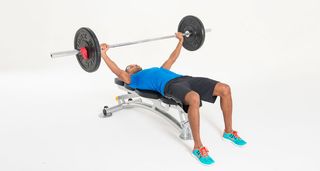
When you join a gym and begin to lift weights, a straightforward beginners’ gym workout or weights machine workout plan will yield results. However, these easy gains are short-lived and you’ll quickly hit a plateau. At that point it’s worth trying something new – and a push/pull workout plan is a tried-and-tested approach.
Below you’ll find two plans. One is a traditional push/pull workout routine where you focus on your upper body for two workouts, then your legs and abs in the third. The other is a variation on a push/pull workout programme called a cross-body plan where you push with the upper body and pull with the lower body in the first workout, swap for the second, then the third workout is the dealer’s choice.
Before we get to the plans, here’s David Wiener, training and nutrition specialist at fitness app Freeletics, to explain what push/pull training is and what kind of gym-goer it will suit best.
Push/Pull Workout Plan FAQs
What is a push/pull workout plan?
“There are two fundamental movements – push and pull,” says Wiener. “On one day you work all the push muscles, and on another all the pull muscles. A push day would be working your shoulders, your triceps, your chest. Then pulling would be doing your back and your biceps.
“Some people do upper-body push, upper-body pull, and then a leg day. Or you can do full-body push and pull. Or you can split the upper-body push and pull, then also do legs push and pull, splitting hamstrings and quads.”
A typical split for a push/pull workout plan, like the one below, will see you in the gym six times a week: push/pull/legs are done consecutively on Monday, Tuesday and Wednesday, and the sequence is then repeated – leaving Sunday as your day of rest.
Is the main benefit that you target different muscles with each push/pull workout?
“Exactly,” says Wiener. “It’s also a way that people can work the same muscle group more than once in a week. If you do push/pull four times a week, you will hit everything twice.
Get the Coach Newsletter
Sign up for workout ideas, training advice, reviews of the latest gear and more.
“It’s also quite time-effective. If you don’t get to train that often, you can potentially hit all your muscles in two workouts, or three if you do legs separately.”
Are there any downsides to push/pull training?
While focusing on one set of muscles can be beneficial, Wiener suggests that it can also mean you don’t get the most of your workouts because of the fatigue created.
“For example, if I’m working my triceps with my chest, I'm fatiguing the muscles in my triceps, which has stopped me getting the most out of my chest because I need the muscles in my triceps for that exercise too,” says Wiener.
“I like to superset push and pull, so while you’re working those push muscles your pull muscles recover. I do chest and biceps, for example. With that I’m actually doing chest, biceps and triceps, because I use the triceps in the chest exercise.”
What kind of gym-goer are push/pull workouts best suited to?
“It’s quite a tough thing to do, so it’s definitely for more advanced gym-goers,” says Wiener. “It can be used by anyone, but you need to be experienced to understand what you’re doing and get the most out of it, and you need to go through a high degree of pain and have a level of endurance. For someone new to the gym a bit of variety is better.”
Push/Pull Workout Plan
“This push/pull workout allows you to hit the major upper-body muscles hard on days one and two before targeting your legs and core on day three,” says personal trainer and fitness model Shaun Stafford.
“Splitting your sessions based on the different movements prevents the muscle groups from being overtrained, which can lead to injury. But because you’ll be exclusively training specific muscles, you’ll be able to hit the gym more. It’s the best way to build more muscle and burn more fat.”
Rest for no more than 60 seconds between sets. Do the exercises in each set in one go with no rests.
How To Warm Up For These Push/Pull Workouts
One of the key benefits of the push/pull workout plan is that you can train more often, so you definitely need to develop a warm-up strategy to ensure your body can handle the toll of regular training. Warming up properly will not only reduce your risk of injury and lessen the DOMS you feel after a workout, it will also allow you to start each session strong and nail the first set of your first lift.
The best way to start your warm-up is with a series of dynamic stretches that get muscles all over the body moving. Give this warm-up routine a try. It works all the major muscle groups to get you prepped for your session.
From there you need to get specific, and by that we mean think about what you’re actually going to do in your workout. There’s little point in doing a push-based warm-up for your pull workout, for example. The simplest way to do this part is to run through a set or two of each exercise from the workout you’re about to do, using light weights or no weight at all. From there you’ll be well prepared to start lifting the heavy stuff.
Push/Pull Workout Plan Day 1: Pull
1 Pull-up
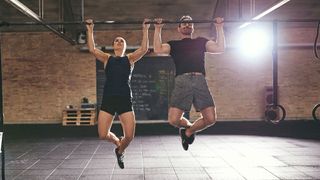
Sets 4 Reps 6 Rest 60sec
Grasp a pull-up bar with an overhand grip so your palms are facing away from you and your hands are shoulder-width apart. Contract your upper back muscles to help pull your chest towards the bar. Lower under control.
2 Bent-over row

Sets 3 Reps 8 Rest 60sec
Holding a barbell (check out our guide to the best barbells you can buy for your home gym) with an overhand grip just outside your legs, bend your knees slightly and hinge forwards from the hips, keeping your back slightly concave and your shoulder blades back throughout. Pull the weight up to your lower chest, then slowly return to the start.
3 Barbell curl
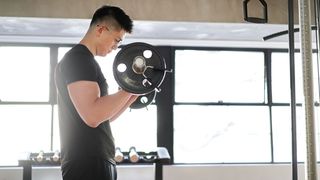
Sets 3 Reps 10 Rest 60sec
Hold a barbell with your hands shoulder-width apart and palms facing forwards. Keeping your chest up and elbows close to your sides, curl the bar up until it’s level with the top of your chest. Lower under control.
4 Cable row

Sets 2 Reps 12 Rest 60sec
Sit with your feet against the supports, bending your legs slightly. Grasp the handle, using the attachment so your palms are facing, retract your shoulder blades and sit upright. Without leaning back, pull the handle towards your lower chest.
5 Lat pull-down
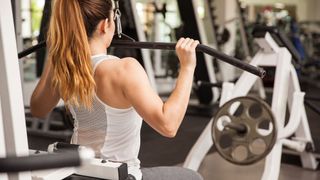
Sets 1 Reps 20 Rest 60sec
Sit in the seat with your knees firmly under the support. Grab the wide bar with hands double shoulder-width apart, palms facing forwards, retract your shoulder blades and sit upright. Without leaning back, pull the handle down in front of your face until it’s level with your chin.
Push/Pull Workout Plan Day 2: Push
1 Bench press
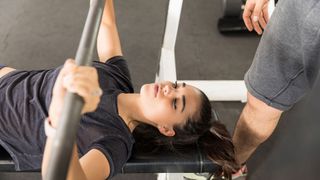
Sets 4 Reps 6 Rest 60sec
Lie on a flat bench holding a barbell with an overhand grip, hands just wider than shoulder-width apart. Drive your feet hard into the floor and press the weight straight up powerfully, then lower slowly to the start position.
2 Decline bench press
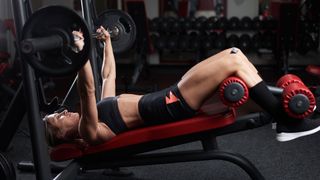
Sets 3 Reps 8 Rest 60sec
Lie on a bench set at a slight decline, holding barbell with an overhand grip, hands just wider than shoulder-width apart. Press the weight straight up powerfully, then lower slowly to the start position.
3 Incline bench press

Sets 3 Reps 10 Rest 60sec
Lie on a bench set at a 45° angle holding a bar with an overhand grip, hands just wider than shoulder-width apart. Drive your feet hard into the floor and press the weight straight up powerfully, then lower slowly to the start position.
4 Overhead press

Sets 2 Reps 12 Rest 60sec
With your feet shoulder-width apart, hold a barbell level with the top of your chest, hands just wider than shoulder-width apart. Keep your core and glutes braced so your hips don’t tilt forwards and press the bar straight overhead, driving your head forwards as you straighten your arms to engage your upper back. Lower back to the start.
5 Clap press-up
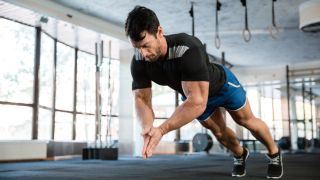
Sets 1 Reps 15 Rest 60sec
Get into the top of a press-up position with your hands directly under your shoulders. Bend your arms to lower your chest almost to the floor, then drive up explosively to bring your hands off the ground and clap in front of your chest. Quickly put your hands back out to brace your fall and continue into the next rep. If you’re struggling, pause briefly between each rep.
Push/Pull Workout Plan Day 3: Legs And Abs
1 Deadlift
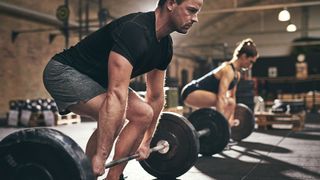
Sets 4 Reps 6 Rest 60sec
Hold a barbell with hands shoulder-width apart and your arms straight, hips low and chest up so your back is straight. Keeping your core tight throughout, drive down through your heels and pull the bar up your legs, pushing your hips forwards to stand tall. Bend forwards, hingeing at your hips until the bar is below your knees, then bend your legs to lower it to the floor.
2 Dumbbell squat
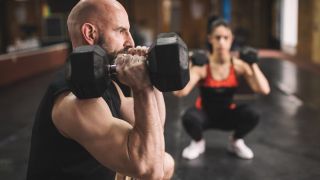
Sets 3 Reps 8 Rest 60sec
Hold a dumbbell in each hand by your sides and stand with your feet shoulder-width apart. Keeping your knees wide apart and weight on your heels throughout, bend your legs to lower until your thighs are at least parallel with the floor. Then drive back up to standing.
3 Good morning
Sets 3 Reps 10 Rest 60sec
Stand holding a barbell on the back of your shoulders, not your neck. Slowly bend forwards, hingeing at the hips, keeping your legs and back straight. Bend until you feel a stretch in your hamstrings, then rise back to the start.
4 Jump lunge
Sets 2 Time 1min Rest 60sec
Start in a forwards lunge position with your hands in a sprinter’s stance for balance. Jump off the ground by driving up with your front leg. Swap your legs over in mid-air so you land with the other leg forwards. Keep alternating for one minute.
5 Hanging leg raise

Sets 1 Reps 20 Rest 60sec
Jump up to grip a pull-up bar with your hands shoulder-width apart and palms facing forwards. Tense your core to stop your body swaying and raise your legs together until they’re at least parallel with the floor. Use your core to lower your legs under control.
Push/Pull Workout Plan Day 4: Rest
Rest day. Then repeat the workouts over the following days.
Cross-Body Push/Pull Workout Plan
When we spoke to Emily Servante, global trainer education manager at Ultimate Performance, to get some advice on how to structure your leg workouts, this cross-body approach was one she suggested as a progression from doing full-body workouts every time you hit the gym.
“With a cross-body split, workout A would consist of upper-body pushing exercises with your chest, shoulders and triceps, and lower-body pulling movements involving the glutes and hamstrings,” says Servante. “Workout B would consist of upper-body pulling moves using the back and biceps, with the quads taking care of the lower-body pushing moves.”
“A third workout of the week could then either concentrate on full-body exercises, or you could add in a specialised workout – for example, a focus on your arms, chest, or back. Or, if you love training your legs, you can add in a specialist legs and glutes workout.”
The last workout is up to you, though we have excellent chest workouts, arms workouts, back workouts and upper-body workouts to pick from, but Servante has provided two cross-body workouts you can use for the push/pull plan.
Workout A: Upper-Body Push, Lower-Body Pull
1A Deadlift
Sets 4 Reps 6-8 Rest 90sec
Stand with your feet shoulder-width apart, with your feet under a barbell resting on the floor. Push your hips back and bend your knees slightly to reach down and take hold of the barbell with your hands just outside of your legs. Keeping your back straight and core braced, drive down through your heels and thrust your hips forwards to stand, pulling the bar up. Hinge forwards to lower the bar under control until it is below your knees, then bend your knees to lower it to the floor.
1B Incline bench press
Sets 4 Reps 6-8 Rest 90sec
Lie on a bench set at 45° holding a bar with an overhand grip, hands just wider than shoulder-width apart. Lower the bar to your sternum, then drive your feet hard into the floor and press the weight straight up powerfully.
2A Lying leg curl
Sets 4 Reps 8-10 Rest 60sec
Lie face down on the leg curl machine with your thighs pressed into the pad and the lever sitting just below your calf muscles. Curl the lever up as far as you can, then lower it slowly.
2B Seated overhead press
Sets 4 Reps 8-10 Rest 60sec
Sit on a bench holding a dumbbell by each shoulder with your palms facing away from you and elbows pointing to the sides. Press the weights directly overhead, then lower to the start under control.
3A Back extension
Sets 4 Reps 10-12 Rest 60sec
Lie on a hyperextension bench so that your upper body hangs over the bench, with your feet secured in the pads at the bottom. Use your hamstrings and glutes to pull your body up so it’s level with the bench, then lower under control.
3B Triceps dip
Sets 3 Reps 10-12 Rest 60sec
Set up on a bench or dipping station with your arms straight and supporting your bodyweight. Bend your elbows to lower your body until your upper arms are parallel to the floor, then push back up.
Workout B: Upper-Body Pull, Lower-Body Push
1A Split squat
Sets 4 Reps 8 Rest 90sec
Rest a barbell on the back of your shoulders. Take a step forwards to adopt a staggered stance with your front foot flat on the floor and on the ball of your rear foot. Bend your knees to lower until your back knee is close to the ground, then drive back up through the heel of your front foot.
1B Chin-up
Sets 4 Reps 6-8 Rest 90sec
Hold a pull-up bar with an underhand grip so your palms are facing you. Pull yourself up until your chin is level with the bar, then lower slowly.
2A Machine squat
Sets 4 Reps 8-10 Rest 60sec
Squat machines vary, so follow the instructions on the model in your gym. Using the machine for your squat allows you to lift more weight and shifts the emphasis to your quads.
2B Prone dumbbell row
Sets 4 Reps 8-10 Rest 60sec
Lie face down on a flat bench holding dumbbells, so your chest is supported by it with your arms hanging down. Lift the weights to the sides of your chest, drawing your elbows past your torso, pause for a moment, then lower under control.
3A Leg press
Sets 3 Reps 12-15 Rest 60sec
Leg press machines vary, so follow the instructions on the model in your gym. Make sure not to lock out your knees while performing the movement.
3B Incline dumbbell curl
Sets 3 Reps 10-12 Rest 60sec
Set a bench up at a 30-45° angle and sit back against it holding your dumbbells with your palms facing away from you. Keeping your upper arms still, bend your elbows to lift the weights to your shoulders, then lower under control.

Joe Warner is a highly experienced journalist and editor who began working in fitness media in 2008. He has featured on the cover of Men’s Fitness UK twice and has co-authored Amazon best-sellers including 12-Week Body Plan. He was the editor of Men’s Fitness UK magazine between 2016 and 2019, when that title shared a website with Coach.
- Nick Harris-FrySenior writer
